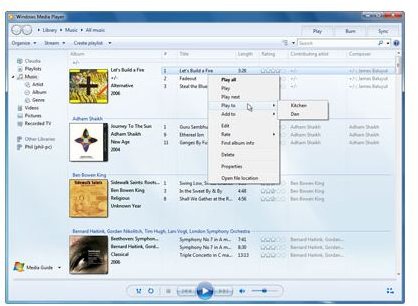Troubleshooting Windows 7 Media Player Problems
Problems with Windows Media Player Codecs
A codec is a small software application that either compresses or decompresses an audio or video file. If your computer’s copy of Windows Media Player is showing an error message regarding missing codecs, you are probably attempting to play a song or a video that has been compressed by a codec that is currently not installed. Some codecs have been created by Microsoft, while the rest have been made by third party companies.
Windows Media Player has a number of built-in codecs, but it may not necessarily include the one that you have to have for your file. For instance, it may have the popular codecs for WMA, WMV and MP3 files, but perhaps not for OGG or Xvid. Luckily, Windows
Media Player gives the option to add as many codecs as you want to make it compatible with files of different formats. Sometimes the player can automatically install the codecs. For that, click the “Now Playing” tab on the player window, and click “More Options.” Then, click “Download codecs automatically.”
The automatic downloads may not necessarily include the codec you want. If you already know the exact name of the codec or its ID, you can search for it over the Internet or find them on the website WM Plugins. An important point to remember when downloading codecs is that you have to specifically download the one that is designed for your operating system. For instance, if your computer is running on the 32-bit Windows 7 version, download codecs for the 32-bit operating system. To find out whether your operating system is 32-bit version or 64-bit, click “Start,” and right-click “Computer.” Information about your operating system will be listed here.
Problems with Audio and Video Playback
If you are experiencing a crackling sound, like the file is playing too fast or slow, the player’s driver software for the sound card is most likely out of date. To update the software, click “Start” > “All Programs” > “Windows Update” > “Check for Updates.” The computer will then

search for the latest updates. If it finds any, click “Install Updates.”
Updating the software will remove certain video issues too, like choppy or flickering video playback, and green lines appearing on the screen. If the video playback problems persist, consider reducing video hardware acceleration by going to “Start” > “Control Panel” > “Appearance and Personalization” > “Personalization” > “Display Settings” > “Advanced Settings” > “Troubleshoot” > “Change Settings.” There will be a “Hardware acceleration” slider that you can slide towards “None."
Dealing with Error Codes
Sometimes Windows Media Player quits abruptly and shows an error message dialog box on the page. The error code typically consists of eight alphanumeric characters. The dialog box containing the code includes a “Web Help” button. If you are connected to the Internet at that time, click this button and Microsoft’s Web Help page will show you the potential causes and solutions for each error, indicated by its error code.
To find more solutions to Windows Media Player 12 problems, see Tips, Tricks and Fixes for Windows Media Player for Windows 7.
Additional Resources
Troubleshooting Windows Media Player Library Issues
References
Images by Writer
Source: Author’s Own Experience
